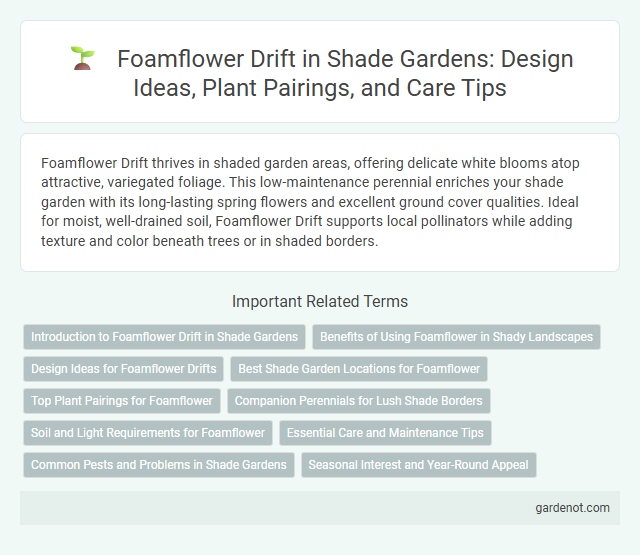Foamflower Drift thrives in shaded garden areas, offering delicate white blooms atop attractive, variegated foliage. This low-maintenance perennial enriches your shade garden with its long-lasting spring flowers and excellent ground cover qualities. Ideal for moist, well-drained soil, Foamflower Drift supports local pollinators while adding texture and color beneath trees or in shaded borders.
Introduction to Foamflower Drift in Shade Gardens
Foamflower Drift (Tiarella cordifolia) thrives in shade gardens, offering delicate white to pinkish flowers that contrast beautifully with dark green, lobed foliage. This low-maintenance perennial prefers moist, well-drained soil and partial to full shade, making it ideal for under trees or in woodland garden settings. Its spreading habit creates a lush groundcover that helps control erosion while providing seasonal interest from spring through early summer.
Benefits of Using Foamflower in Shady Landscapes
Foamflower (Tiarella cordifolia) thrives in shaded garden areas, providing dense ground cover that suppresses weeds while enhancing soil moisture retention. Its delicate, foam-like blossoms attract pollinators such as bees and butterflies, promoting biodiversity in shady landscapes. The plant's adaptable growth and low maintenance needs make it an excellent choice for adding texture and visual interest under trees or in woodland gardens.
Design Ideas for Foamflower Drifts
Foamflower drifts create a lush, textured carpet of delicate white blooms and heart-shaped leaves, ideal for shade gardens with dappled sunlight. Pairing them with ferns and hostas enhances visual contrast while maintaining moisture-loving plant harmony. Grouping Foamflower in masses along shaded woodland paths or under deciduous trees amplifies their naturalistic, serene effect.
Best Shade Garden Locations for Foamflower
Foamflower drift thrives best in shaded garden locations with moist, well-drained soil, such as under deciduous trees or alongside shaded woodland paths. Ideal areas include northern or eastern exposures that provide filtered sunlight, preventing leaf scorch and promoting lush foliage. Incorporating Foamflower in these environments enhances ground cover with delicate white blooms and vibrant autumn foliage.
Top Plant Pairings for Foamflower
Foamflower drift thrives alongside hostas and ferns, creating a lush, textured shade garden palette that enhances its delicate white blooms. Pairing Foamflower with astilbe adds vibrant color contrast while maintaining moisture-loving conditions essential for its growth. Combining these perennials ensures year-round interest and a harmonious understory in shaded landscapes.
Companion Perennials for Lush Shade Borders
Foamflower Drift (Tiarella cordifolia) pairs exceptionally well with hostas and astilbes to create lush, layered shade garden borders. Its delicate white blooms and attractive foliage complement the bold textures of ferns and heucheras, enhancing visual interest throughout the growing season. Selecting moisture-loving perennials like Solomon's seal and bleeding hearts ensures a thriving, diverse understory in shady areas.
Soil and Light Requirements for Foamflower
Foamflower drift thrives best in moist, well-drained, humus-rich soil that retains consistent moisture without becoming waterlogged. It prefers partial to full shade conditions, making it ideal for shaded garden areas where direct sunlight is limited. These soil and light requirements promote optimal foliage growth and abundant, delicate white blooms throughout the growing season.
Essential Care and Maintenance Tips
Foamflower drift thrives in moist, well-drained soil with consistent shade exposure, making it ideal for shade gardens. Regular watering during dry spells ensures vibrant foliage and prolonged blooming periods, while mulching helps retain soil moisture and regulate temperature. Pruning spent flowers and removing dead leaves promote healthy growth and prevent disease.
Common Pests and Problems in Shade Gardens
Foamflower drift (Tiarella cordifolia) in shade gardens often faces issues with slugs and snails, which can cause significant leaf damage. Powdery mildew is another common problem, thriving in humid, shaded conditions and leading to white, powdery fungal growth on foliage. Proper air circulation and regular inspection help minimize these pests and diseases, ensuring healthy growth.
Seasonal Interest and Year-Round Appeal
Foamflower Drift offers exceptional seasonal interest with its delicate, foamy white blossoms that brighten shady garden areas in spring. Its attractive, heart-shaped foliage changes from bright green in spring to burgundy in fall, providing year-round visual appeal. This low-maintenance groundcover thrives in shade, making it ideal for adding texture and color throughout all seasons.
Foamflower drift Infographic

 gardenot.com
gardenot.com